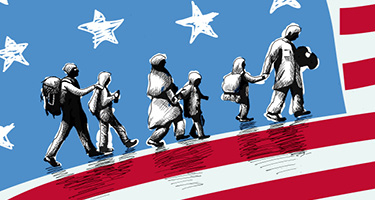Whether you’re sponsoring a foreign-born family member or applying for your own visa, navigating the U.S. immigration system can be a daunting task. In addition to changing policies and complex government forms, applicants are now facing record-breaking backlogs and processing delays.
If you’re an LGBTQIA+ couple trying to start your lives together in the United States, you may also be wondering about your immigrant rights and what hurdles you might face during the marriage green card application process.
Understanding Your Legal Rights
Under U.S. immigration law, same-sex couples are able to apply for green cards if one partner is a U.S. citizen or green card holder. This hasn’t always been the case—in the last decade, two landmark Supreme Court decisions changed the course of LGBTQIA+ immigrant rights in the U.S. and made marriage visas for same-sex couples possible.
In 2013, United States v. Windsor challenged the constitutionality of the Defense of Marriage Act (DOMA), a federal statute which defined legal marriage as a union between one man and one woman. Ruling in favor of same-sex marriage, the court ultimately declared this aspect of DOMA to be unconstitutional. The case determined that the U.S. government cannot discriminate against same-sex couples who seek government benefits and protections, including immigration benefits.
Two years after breaking ground with U.S. v. Windsor, the U.S. Supreme Court ruled again to protect LGBTQIA+ couples on a federal level and declared that state bans on same-sex marriage were unconstitutional. The ruling of Obergefell v. Hodges required that all 50 U.S. states perform and recognize legal marriages for same-sex couples.
These two rulings in favor of same-sex marriage directly impacted U.S. immigration policy. In 2013, marriage green cards became available for LGBTQIA+ couples, with the expectation that U.S. Citizenship and Immigration Services (USCIS) treat applications from same-sex couples the same as applications from heterosexual couples. Boundless Immigration dives deeper into the history of LGBTQIA+ immigration policy and how it has evolved here.
All Marriages are Equal Under U.S. Law
All LGBTQIA+ couples who are legally married can apply for marriage green cards, whether or not the foreign spouse’s home country recognizes same-sex marriage. The only government requirement is that the marriage must have occurred in a country that legally recognizes same-sex marriage.
What about civil unions? Prior to marriage equality in the U.S., many same-sex couples opted for civil unions that provided similar benefits to legal marriage. Couples in civil unions however are not eligible for immigration benefits—you and your spouse must be legally married to qualify for a marriage green card.
Another important piece of every marriage green card application is proving to the government that you have an authentic, or “bona fide,” marriage. This step of the process typically involves providing “evidence of relationship” documents—anything from proof of combined finances, cohabitation or even sworn affidavits from family or friends attesting to the legitimacy of your marriage. For LGBTQIA+ couples who have to hide relationships from their family or workplace due to fear of discrimination or persecution, navigating the “bona fide” marriage requirement can be a challenge. This same-sex marriage guide has some helpful tips on how to compile sufficient supporting documents and explain your situation to immigration officers.
Same-sex couples may also have concerns about biased government officials during the marriage green card process. If immigration officers are allowed to use their discretion when reviewing applications, how can you ensure your case will be evaluated fairly? Luckily, all immigration officers now undergo sensitivity training on LGBTQIA+ issues and are required by law to treat all applications equally.
What the Marriage Green Card Process Looks Like
In general, the marriage green card application is the same for LGBTQIA+ couples as it is for heterosexual couples. LGBTQIA+ couples complete the same required government forms, submit the same supporting documents and must fulfill the same eligibility requirements that apply to all marriage green card applicants.
The first step of every marriage green card application is filing Form I-130, officially called the “Petition for Alien Relative.” Form I-130 (which has its own requirements, supporting documents and filing costs) establishes the marriage relationship and is the first in a series of government forms to submit. The additional forms and documents the couple must submit depend on where the foreign-born spouse currently resides.
If the foreign-born spouse already lives in the U.S., they’ll likely apply for their marriage green card via a process known as “adjustment of status,” while those that live abroad will follow the “consular processing” path. Regardless of which process applies to you, all marriage green card applicants are also required to undergo a medical exam and visa interview to prove they are admissible to the U.S.
LGBTQIA+ couples interested in applying for marriage green cards should know their immigration rights and read up on the application process to better understand what forms, documents and costs are required for their specific situation. A breakdown of common questions during each stage of the immigration journey and additional resources for LGBTQIA+ couples can be found here.
































